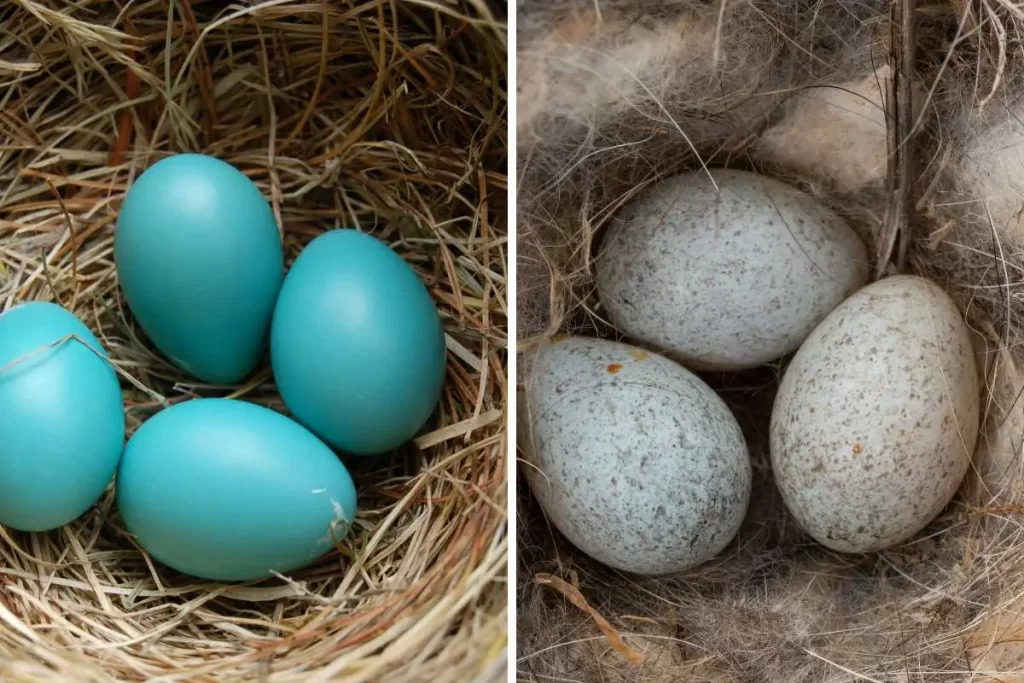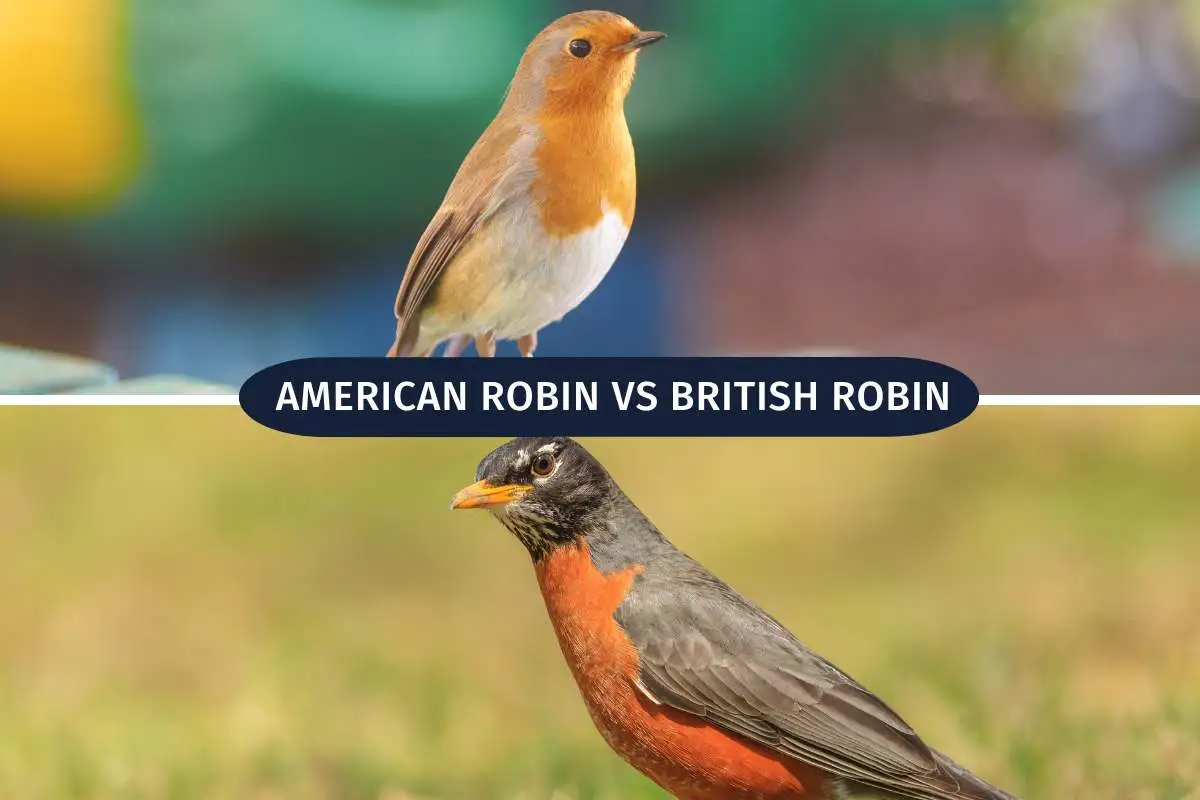The American Robin and the British Robin are two different species of birds, although they are both parts of the same family, Turdidae. Despite their similar names, these two species have several notable differences.
Key Difference: American Robin vs. British Robin:
| Characteristic | American Robin | British Robin |
| Size | 11 inches long, 16 inch wingspan | 5 inches long, 8 inch wingspan |
| Appearance | Reddish-orange breast, dark head and back, white belly | Reddish-orange breast and face, brown back and wings, white belly |
| Habitat | North America (found throughout most of the US and Canada) | Europe, Asia, and parts of North Africa |
In terms of behavior, the American Robin and the British Robin are typically active during the day. They are known for their cheerful songs. However, the American Robin is more likely to be found in larger groups, while the British Robin is more solitary.
Overall, while the American Robin and the British Robin may have similar names and belong to the same family, these two species have several key differences.
American Robin and British Robin: Egg size, color, markings

Here is a table comparing the eggs of American Robins and British Robins:
| Characteristic | American Robin | British Robin |
| Number of eggs per clutch | Typically 3-5 | Typically 4-6 |
| Color | Pale blue-green | Creamy white |
| Size | 0.8 inches long, 0.6 inches wide | 0.7 inches long, 0.5 inches wide |
| Markings | Fine speckling | None or faint speckling |
As you can see, American Robins and British Robins lay similar-sized eggs, but there are some notable differences between the two species.
American Robins lay eggs that are pale blue-green, while British Robins lay eggs that are creamy white. The eggs of both species are typically marked with fine speckling, but the markings on the eggs of American Robins may be slightly more pronounced.
Additionally, American Robins usually lay 3-5 eggs per clutch, while British Robins typically lay 4-6 eggs per clutch.
American Robin Vs British Robin: Diet
American Robins and British Robins have similar diets, as they primarily feed on insects, worms, and other invertebrates, as well as fruits and berries. They are also known to eat a variety of insects, including beetles, grasshoppers, caterpillars, etc.
Here is a table comparing the diet of American Robins and British Robins:
| Food type | American Robin | British Robin |
| Insects | Beetles, grasshoppers, caterpillars | Beetles, flies, spiders |
| Fruits and berries | Cherries, grapes, berries | Blackberries, raspberries, blueberries |
As you can see, American Robins and British Robins have similar diets, but there are some differences in the specific types of insects and fruits that they eat. American Robins tend to eat a wider variety of insects and fruits than British Robins. Know more about American robin from my recent publish article.
American Robin Vs British Robin: Migration Pattern
American Robins and British Robins have different migration patterns. American Robins migrate in the winter, moving south to avoid the colder weather. They typically migrate in large flocks and can travel hundreds or even thousands of miles to reach their wintering grounds.
British Robins, on the other hand, are sedentary birds, which means they do not migrate. They typically remain in the same area throughout the year unless they cannot find sufficient food or shelter.
Some British Robins may move to a different area if the conditions in their current habitat become unfavorable, but they do not undertake long-distance migrations like American Robins.
American Robin and British Robin: Behavior
Here is a table comparing the behavior of American Robins and British Robins:
| Characteristic | American Robin | British Robin |
| Social behavior | More social; often seen in large flocks | More solitary; usually seen alone or in pairs |
| Feeding habits | Forage for food on the ground | More agile, often catch insects in mid-air |
| Migration | Migrate in the winter | Sedentary, do not migrate |
| Song | Known for their cheerful songs | Known for their cheerful songs |
As you can see, American Robins and British Robins have similar behaviors, such as their cheerful songs. Still, the two species also have some key differences, such as their social behavior and migration patterns.
American Robin vs British Robin: Reproduction and Lifespan
Here is a table comparing the reproduction and lifespan of American Robins and British Robins:
| Characteristic | American Robin | British Robin |
| Lifespan | Typically 2-3 years | Typically 3-4 years |
| Age at sexual maturity | 1 year | 1 year |
| Breeding season | March-July | April-July |
| Number of eggs per clutch | Typically 3-5 | Typically 4-6 |
| Incubation period | 12-14 days | 12-15 days |
| Fledging period | 11-14 days | 11-15 days |
As you can see, American Robins and British Robins have similar lifespans, with both species typically living for 2-3 years in the wild. They also reach sexual maturity at around the same age, and have similar breeding seasons and incubation periods.
However, there are some notable differences between the two species, including the number of eggs they lay per clutch and the length of the fledging period.
American Robins typically lay 3-5 eggs per clutch and have a fledging period of 11-14 days, while British Robins typically lay 4-6 eggs per clutch and have a fledging period of 11-15 days.
British Robin vs American Robin: Classification
The classification of American Robins and British Robins:
| Characteristic | American Robin | British Robin |
| Scientific name | Turdus migratorius | Erithacus rubecula |
| Kingdom | Animalia | Animalia |
| Phylum | Chordata | Chordata |
| Class | Aves | Aves |
| Order | Passeriformes | Passeriformes |
| Family | Turdidae | Turdidae |
| Genus | Turdus | Erithacus |
| Species | Migratorius | Rubecula |
As you can see, American Robins and British Robins are both members of the Turdidae family of birds, which includes all thrushes. However, they belong to different genera and species within the Turdidae family.
American Robins are classified as Turdus migratorius, while British Robins are classified as Erithacus rubecula. While they have some similarities in their classification, there are also some notable differences between the two species.

